Glioblastoma is one of the most common brain cancers. It affects people of all ages. It usually starts in star-shaped cells called astrocytes. These protect neurons and carry nutrients to them.
Glioblastoma often grows quickly. It may spread to other parts of the brain or spinal cord. It can cause headaches, memory loss and motor weakness.
Symptoms
Glioblastoma is a cancerous brain tumor. It’s one of the fastest-growing and most aggressive types of brain tumor. Its rapid growth makes it difficult to treat. It also spreads quickly to other areas of the brain. The prognosis is poor.
Doctors don’t know what causes glioblastoma. The cells that form the tumor are called glial cells. They normally help support and nourish nerve cells in the brain (neurons). They may also help repair damage to the brain caused by illness or injury. Glioblastomas grow into and destroy surrounding brain tissue. They are also known as primary brain tumors because they develop directly from glial cells.
There are many different kinds of gliomas. Doctors put them into groups based on how fast they grow and how abnormal their cells look. They also look at the location of the tumor and whether it has certain mutations. Doctors use this information to determine the grade of the glioma.
The most common symptoms of a glioblastoma are blurred vision, headache, nausea and vomiting, memory loss and difficulty thinking clearly. These symptoms are caused by the growth of the tumor and the pressure it puts on the skull. The skull is a closed space with finite room for the brain, so excess pressure can cause headaches, weakness on one side of the body and numbness. Seizures occur in about 45 percent of people with a GBM and are the most dangerous symptom of this type of tumor.
Other symptoms include trouble swallowing, trouble walking and problems with speech. Some people become more irritable or emotional. Many people have difficulty sleeping because of the tumor. They may also have trouble concentrating and paying attention in class or at work.
It’s not unusual for people with a glioblastoma to feel depressed or anxious. Doctors can prescribe medications to help manage these symptoms.
Doctors diagnose a glioblastoma by examining the brain and asking questions about your past health. They may recommend magnetic resonance imaging (MRI) or computed tomography (CT) scans to see the size of the tumor and its location. They may recommend a biopsy to confirm the diagnosis and find out what kind of glioblastoma you have.
Diagnosis
Glioblastoma starts in cells that normally help support and nourish brain nerve cells (neurons). When these cells begin to grow out of control, they form a tumor. This tumor can press against and infiltrate neighboring brain tissue, leading to symptoms such as headaches, confusion, memory loss, weakness or seizures.
These tumors are hard to detect. Symptoms are often gradual and mild at first, such as headaches or changes in how you think or feel. Symptoms get worse over time and may include vision problems, loss of balance or coordination or difficulty walking. The tumor can also press against the optic nerve, causing swelling that affects how you see and what you’re able to do.
Doctors use a combination of tests to diagnose glioblastoma. These include a physical exam, brain imaging with computed tomography (CT) or magnetic resonance imaging (MRI) and a brain biopsy. A brain biopsy is a surgical procedure in which doctors remove a small piece of the tumor. They then study the sample under a microscope to confirm the diagnosis of a glioblastoma and identify its type.
The cancer cells can grow into and spread to other parts of the brain if they haven’t been completely removed by surgery. They can also grow into the spinal cord and cause problems with the bladder, bowel or eyes. Glioblastomas can also break away from the main part of the brain and go into the lungs, where they are sometimes found in patients with metastatic glioblastoma.
Doctors don’t know what causes glioblastoma, but they have identified some risk factors. They include prior radiation to the head, which can happen in people who receive treatment for other brain tumors or cancers that have spread to the brain. It’s also more common in men than women and people over the age of 50.
Another factor is that a mutation in the gene called MGMT turns off DNA repair, which can make the cancer cells more likely to survive and grow. Using drugs that turn back on MGMT can stop this mutation and help the chemotherapy drugs work better.
Treatment
The outlook for glioblastoma is improving thanks to advances in both research and treatment. Doctors are working to understand how these tumors grow, so they can better predict how fast the cancer will spread. They are also developing new treatments to slow the growth of the cancer and improve survival.
Glioblastoma is a brain cancer that begins in star-shaped cells called astrocytes. These cells support nerve cell function, give the brain its shape and supply it with nutrients. Glioblastoma forms in these cells and grows quickly, forming tumors that are often visible on an MRI or CT scan.
A neurologist will do an exam to find out the cause of your symptoms and determine if you have a glioblastoma. They may order an MRI or CT scan and other tests to help them make the diagnosis.
These brain tumors grow into and destroy healthy brain tissue. They can also grow into blood vessels and spread to other parts of the body. Symptoms might include headache that gets worse, nausea, vomiting, blurred vision and seizures.
During surgery, doctors try to remove the tumor. The brain surgeon, also known as a neurosurgeon, works to get as much of the tumor out as possible. But the tumor might grow back, even if all of the cells are removed. The doctor might then use other treatments to kill the remaining cancer cells.
There is no cure for glioblastoma, but doctors can use a combination of treatments to reduce the size of the tumor, shrink the area around the tumor and ease other symptoms. These treatments might include radiation, chemotherapy and a drug that helps your immune system attack the cancer cells.
Doctors can also use special tests to check if your cancer cells have certain gene changes. These are sometimes called molecular tests. Your doctor will look for permanent changes (mutations) in a gene called IDH. Mutations might explain why your glioblastoma is more likely to grow and spread.
Another treatment option is tumor treating fields therapy. During this procedure, sticky pads are placed on your head and wires connect the pads to a portable device. The device emits an electrical field that hurts the glioblastoma cells.
Follow-up
Glioblastoma patients need regular follow-up care to watch for signs that the cancer has come back (recurred). This will include regularly scheduled MRIs and sometimes positron emission tomography (PET) scans. In addition, doctors will talk to patients about what to expect as the disease progresses. They will also discuss ways to manage symptoms that may occur.
Until recently, treatment options for glioblastoma in older adults were limited to radiation therapy and the chemotherapy drug temozolomide. But a pivotal study showed that adding bevacizumab to radiation and temozolomide improved survival in this population of patients.
Cutting-edge immune-based treatments that have shown promise in other cancer types are now under evaluation in glioblastoma clinical trials. One approach involves creating a personalized vaccine for the tumor using a patient’s own cells. These dendritic cells are then injected back into the patient, along with a drug called pembrolizumab that blocks the ability of the cancer to blunt the patient’s own immune response. This combination therapy is referred to as immunotherapy. It is the focus of many ongoing glioblastoma studies.









